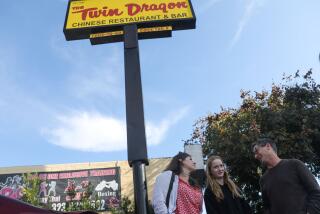Holiday China and the New Pattern of Boomer Buying
- Share via
Sarah Cox never felt that the holidays had really arrived until her mother started using the family’s set of Christmas china. “My parents would have a party every Christmas Eve,” says Cox, now a 33-year-old attorney in Los Angeles. “My mother would put her Spode Christmas Tree dishes out and, to a little girl, it was a big deal. It was a symbol of something that was especially Christmasy and special.”
Spode’s Christmas Tree line, a white china featuring a decorated tree with brightly wrapped gifts waiting underneath, debuted in 1937--the first holiday pattern available in the U.S.
For a generation that survived the Great Depression and didn’t spend money easily, the china was something precious, to be collected slowly. Many people bought a place setting one year, mugs the next, acquiring pieces as the holidays passed.
But that’s not the boomer way--and new holiday patterns at mass-market stores such as Pottery Barn and Crate and Barrel prove it.
“Now yuppies who can afford it are buying complete sets of what they like,” said Susan Ross, spokeswoman for Ross-Simons, the largest china, crystal and silver distributor in the country.
“It used to be that young couples could only get a big set of china if their grandparents or their parents were buying it for them, but with a strong economy, buying patterns are definitely shifting,” she said. “People are spending a lot of money on themselves.”
This year Pottery Barn is offering Reindeer, a china pattern that features contemporary drawings of different members of Santa’s sleigh-pulling team, while Crate and Barrel has ‘Twas the Night Before Christmas. The sets actually are not less expensive than their fine china counterparts: For example, a set of four-piece place settings for eight in the Reindeer pattern is $300, while eight four-piece Christmas Tree place settings cost $290.
The difference is in the collectibility. Chain stores sell their patterns for a year or two before discontinuing them. In contrast, fine china patterns are sold indefinitely--and more are entering the market each year.
“In the last 10 years, all the major fine porcelain and china houses have come out with their own holiday dishes, from very simple to very extravagant patterns,” said Tom Blumenthal, senior vice president of Gearys in Beverly Hills.
The china companies, launching patterns with names such as Christmas Rose, Green Garland and Holiday Ribbons, have adopted the strategy that Spode pioneered with Christmas Tree. Just when a buyer thinks all she needs to be happy is a cheeseboard and knife in her favorite design, an irresistible pasta bowl appears. “The companies that make Christmas china are so creative, and they keep coming up with fabulous ideas that entice the customer to buy more,” said Ross-Simons’ Ross.
The best-selling pattern for Ross-Simons, which operates 10 retail stores and distributes a catalog, is the Lenox Holiday China pattern, a cream china encircled with holly and gold trim. “It’s American-made,” Ross said. “People feel that Lenox will still be making that china 200 years from now, so it’s OK to invest in it.”
Gearys’ most popular pattern is Grenadiers, by the French porcelain maker Bernardaud, which features tin soldiers on a bright, white plate. A dinner service for eight costs $1,160.
Cox’s bridal registry listed Grenadiers, along with a regular china pattern, when she was married in February. “Christmas traditions are important to me,” she said. “We’ll use our new Christmas china for the first time this year, just the two of us. We got some dinner plates to start with, and I’m sure I’ll add a little every year.
“To my husband’s horror, I’m terribly impatient, though.”
More to Read
Inside the business of entertainment
The Wide Shot brings you news, analysis and insights on everything from streaming wars to production — and what it all means for the future.
You may occasionally receive promotional content from the Los Angeles Times.










